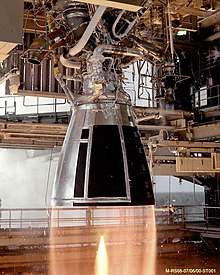If you want maximum performance, it must be well-designed.
Each propellant acts differently in terms of pressure, temperature, etc. So the engine is designed according to the propellant that will be used.
Mechanically speaking, it must withstand the high temperature without melting and the high pressure resulting from the combustion without bursting.
To avoid melting the engine, it must be cooled. There are several ways to cool it : passively and actively.
Passive cooling is a manner that not use additional energy but is limited in efficiency and cooling power.
Two way exists : radiation cooling and ablative cooling.
 |
| A big rocket engine test firing |
The second is done by putting a layer of resin (or something else like plastic for small engine) in between the engine's walls and the propellant so that the resin is vaporized by the combustion's heat. This technique is efficient, cheap and adapted to solid-fueled rockets but the ablative is consumed and must be replenished between each launch.
Actively cooling the rocket requires additional energy but is efficient and adapted to big rockets.
The general principle is to run the liquid propellant through (generally copper) tubings that are welded on the engine so that it can absorb the heat like a water-cooling. It only works on liquid and hybrid rockets because the propellants has to be a fluid.
Ablative cooling is the cooling technique we will use in our little rocket engine. It's the most efficient and cheapest way to cool it.
No comments:
Post a Comment